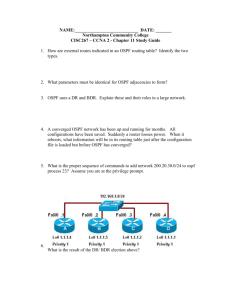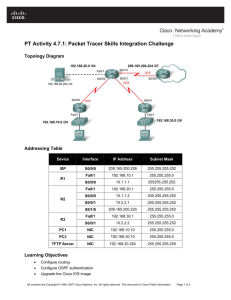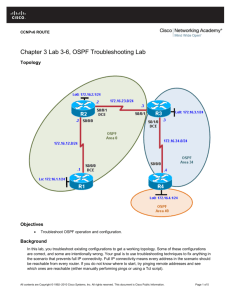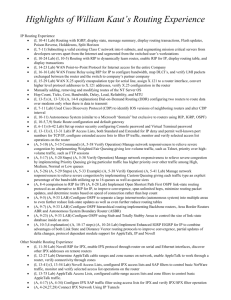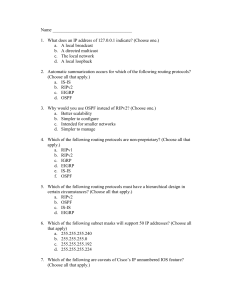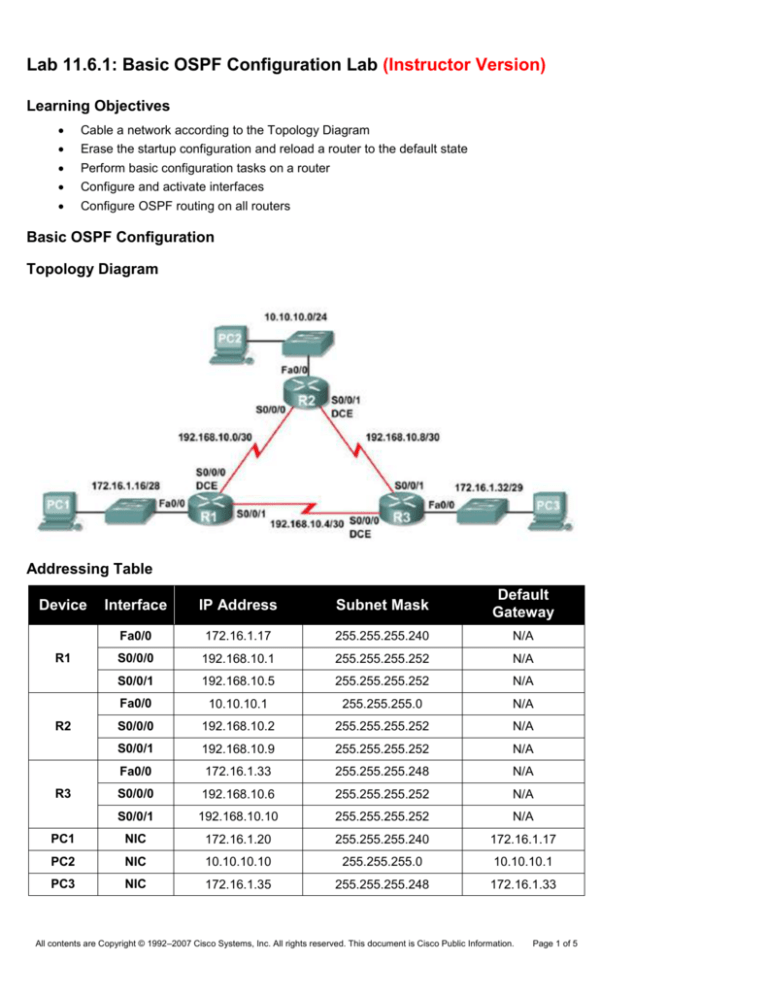
Lab 11.6.1: Basic OSPF Configuration Lab (Instructor Version)
Learning Objectives
Cable a network according to the Topology Diagram
Erase the startup configuration and reload a router to the default state
Perform basic configuration tasks on a router
Configure and activate interfaces
Configure OSPF routing on all routers
Basic OSPF Configuration
Topology Diagram
Addressing Table
Interface
IP Address
Subnet Mask
Default
Gateway
Fa0/0
172.16.1.17
255.255.255.240
N/A
S0/0/0
192.168.10.1
255.255.255.252
N/A
S0/0/1
192.168.10.5
255.255.255.252
N/A
Fa0/0
10.10.10.1
255.255.255.0
N/A
S0/0/0
192.168.10.2
255.255.255.252
N/A
S0/0/1
192.168.10.9
255.255.255.252
N/A
Fa0/0
172.16.1.33
255.255.255.248
N/A
S0/0/0
192.168.10.6
255.255.255.252
N/A
S0/0/1
192.168.10.10
255.255.255.252
N/A
PC1
NIC
172.16.1.20
255.255.255.240
172.16.1.17
PC2
NIC
10.10.10.10
255.255.255.0
10.10.10.1
PC3
NIC
172.16.1.35
255.255.255.248
172.16.1.33
Device
R1
R2
R3
All contents are Copyright © 1992–2007 Cisco Systems, Inc. All rights reserved. This document is Cisco Public Information.
Page 1 of 5
CCNA Exploration
Routing Protocols and Concepts: OSPF
Lab 11.6.1: Basic OSPF Configuration Lab
Task 1: Prepare the Network.
1. Cable a network that is similar to the one in the Topology Diagram.
Použijte směrovače 1841, u kterých instalujete modul WIC-2T do pravého slotu.
2. Clear any existing configurations on the routers.
Task 2: Perform Basic Router Configurations.
Perform basic configuration of the R1, R2, and R3 routers:
1. Configure the router hostname. Ke každému jménu přidejte svoje příjmení, např. R2_Kucera.
2. Disable DNS lookup.
Task 3: Configure and Activate Serial and Ethernet Addresses.
1. Configure interfaces on R1, R2, and R3.
Configure the interfaces on the R1, R2, and R3 routers with the IP addresses from the table.
2. Verify IP addressing and interfaces.
Use the show ip interface brief command to verify the IP addressing.
Save the running configuration to the NVRAM.
3. Configure Ethernet interfaces of PC1, PC2, and PC3.
Configure the Ethernet interfaces of PC1, PC2, and PC3 with the IP addresses and default gateways from the table.
4. Test the PCs configuration by pinging the default gateway from the PCs.
Task 4: Configure OSPF on the R1 Router
1. Enable OSPF on the R1 router.
Enter a process ID of 1 for the process-ID parameter.
R1(config)#router ospf 1
R1(config-router)#
All contents are Copyright © 1992–2007 Cisco Systems, Inc. All rights reserved. This document is Cisco Public Information.
Page 2 of 5
CCNA Exploration
Routing Protocols and Concepts: OSPF
Lab 11.6.1: Basic OSPF Configuration Lab
2. Configure the router to advertise the LAN network.
Configure the LAN network 172.16.1.16/28 to be included in the OSPF updates that are sent out of R1.
The OSPF network command uses network-address and wildcard-mask.
Use an area ID of 0 for the OSPF area-id parameter.
0 will be used for the OSPF area ID in all of the network statements in this topology.
R1(config-router)#network 172.16.1.16 0.0.0.15 area 0
R1(config-router)#
3. Configure the router to advertise the 192.168.10.0/30 network attached to the Serial0/0/0 interface.
R1(config-router)# network 192.168.10.0 0.0.0.3 area 0
R1(config-router)#
4. Configure the router to advertise the 192.168.10.4/30 network attached to the Serial0/0/1 interface.
R1(config-router)# network 192.168.10.4 0.0.0.3 area 0
R1(config-router)#
Task 5: Configure OSPF on the R2 and R3 Routers
1. Enable OSPF routing on the R2 router using the router ospf command.
Use a process ID of 1.
R2(config)#router ospf 1
R2(config-router)#
2. Configure the router to advertise the LAN network 10.10.10.0/24.
R2(config-router)#network 10.10.10.0 0.0.0.255 area 0
R2(config-router)#
3. Configure the router to advertise the 192.168.10.0/30 network attached to the Serial0/0/0 interface.
R2(config-router)#network 192.168.10.0 0.0.0.3 area 0
R2(config-router)#
4. Configure the router to advertise the 192.168.10.8/30 network attached to the Serial0/0/1 interface.
R2(config-router)#network 192.168.10.8 0.0.0.3 area 0
R2(config-router)#end
%SYS-5-CONFIG_I: Configured from console by console
R2#
5. Configure OSPF on the R3 router using the router ospf and network commands.
Use a process ID of 1. Configure the router to advertise the three directly connected networks.
R3(config)#router ospf 1
R3(config-router)#network 172.16.1.32 0.0.0.7 area 0
R3(config-router)#network 192.168.10.4 0.0.0.3 area 0
R3(config-router)#
R3(config-router)#network 192.168.10.8 0.0.0.3 area 0
R3(config-router)#
R3(config-router)#end
All contents are Copyright © 1992–2007 Cisco Systems, Inc. All rights reserved. This document is Cisco Public Information.
Page 3 of 5
CCNA Exploration
Routing Protocols and Concepts: OSPF
Lab 11.6.1: Basic OSPF Configuration Lab
%SYS-5-CONFIG_I: Configured from console by console
R3#
Task 6: Configure OSPF Router IDs
The OSPF router ID is used to uniquely identify the router in the OSPF routing domain. A router ID is an IP address. Cisco
routers derive the Router ID in one of three ways and with the following precedence:
1. IP address configured with the OSPF router-id command.
2. Highest IP address of any of the router’s loopback addresses.
3. Highest active IP address on any of the router’s physical interfaces.
1. Examine the current router IDs in the topology.
Since no router IDs or loopback interfaces have been configured on the three routers, the router ID for each router is
determined by the highest IP address of any active interface.
What is the router ID for R1? _________192.168.10.5___________
What is the router ID for R2? _________192.168.10.9___________
What is the router ID for R3? _________192.168.10.10___________
The router ID can also be seen in the output of the show ip protocols, show ip ospf, and show ip ospf
interfaces commands.
R3#show ip protocols
Routing Protocol is "ospf 1"
Outgoing update filter list for all interfaces is not set
Incoming update filter list for all interfaces is not set
Router ID 192.168.10.10
Number of areas in this router is 1. 1 normal 0 stub 0 nssa
Maximum path: 4
R3#show ip ospf
Routing Process "ospf 1" with ID 192.168.10.10
………………………………………………………
R3#show ip ospf interface
FastEthernet0/0 is up, line protocol is up
Internet address is 172.16.1.33/29, Area 0
Process ID 1, Router ID 192.168.10.10, Network Type BROADCAST, Cost: 1
Transmit Delay is 1 sec, State DR, Priority 1
………………………………………………………………….
R3#
2. Use loopback addresses to change the router IDs of the routers in the topology.
R1(config)#interface loopback 0
R1(config-if)#ip address 10.1.1.1 255.255.255.255
R2(config)#interface loopback 0
R2(config-if)#ip address 10.2.2.2 255.255.255.255
R3(config)#interface loopback 0
R3(config-if)#ip address 10.3.3.3 255.255.255.255
3. Reload the routers to force the new Router IDs to be used.
All contents are Copyright © 1992–2007 Cisco Systems, Inc. All rights reserved. This document is Cisco Public Information.
Page 4 of 5
CCNA Exploration
Routing Protocols and Concepts: OSPF
Lab 11.6.1: Basic OSPF Configuration Lab
When a new Router ID is configured, it will not be used until the OSPF process is restarted. Save the current configuration to
NRAM, and then use the reload command to restart each of the routers..
When the router is reloaded, what is the router ID for R1? _________10.1.1.1___________
When the router is reloaded, what is the router ID for R2? _________10.2.2.2___________
When the router is reloaded, what is the router ID for R3? _________10.3.3.3___________
4. Use the show ip ospf neighbors command to verify that the router IDs have changed.
R1#show ip ospf neighbor
Neighbor ID
Pri
State
10.3.3.3
0 FULL/ 10.2.2.2
0
FULL/ R2#show ip ospf neighbor
Neighbor ID
Pri
State
10.3.3.3
0
FULL/
10.1.1.1
0
FULL/
Dead Time
00:00:30
00:00:33
Address
192.168.10.6
192.168.10.2
Interface
Serial0/0/1
Serial0/0/0
-
Dead Time
00:00:36
00:00:37
Address
192.168.10.10
192.168.10.1
Interface
Serial0/0/1
Serial0/0/0
-
Dead Time
00:00:34
00:00:38
Address
192.168.10.9
192.168.10.5
Interface
Serial0/0/1
Serial0/0/0
R3#show ip ospf neighbor
Neighbor ID
10.2.2.2
10.1.1.1
Pri
0
0
State
FULL/
FULL/
Task 7: Examine OSPF Routes in the Routing Tables
View the routing table on the R1 router. OSPF routes are denoted in the routing table with an “O”.
R1#show ip route
Codes: C - connected, S - static, I - IGRP, R - RIP, M - mobile, B - BGP
D - EIGRP, EX - EIGRP external, O - OSPF, IA - OSPF inter area
N1 - OSPF NSSA external type 1, N2 - OSPF NSSA external type 2
E1 - OSPF external type 1, E2 - OSPF external type 2, E - EGP
i - IS-IS, L1 - IS-IS level-1, L2 - IS-IS level-2, ia - IS-IS inter area
* - candidate default, U - per-user static route, o - ODR
P - periodic downloaded static route
Gateway of last resort is not set
C
O
C
O
C
C
O
10.0.0.0/8 is variably subnetted, 2 subnets, 2 masks
10.1.1.1/32 is directly connected, Loopback0
10.10.10.0/24 [110/65] via 192.168.10.2, 00:01:02, Serial0/0/0
172.16.0.0/16 is variably subnetted, 2 subnets, 2 masks
172.16.1.16/28 is directly connected, FastEthernet0/0
172.16.1.32/29 [110/65] via 192.168.10.6, 00:01:12, Serial0/0/1
192.168.10.0/30 is subnetted, 3 subnets
192.168.10.0 is directly connected, Serial0/0/0
192.168.10.4 is directly connected, Serial0/0/1
192.168.10.8 [110/128] via 192.168.10.6, 00:01:12, Serial0/0/1
[110/128] via 192.168.10.2, 00:01:02, Serial0/0/0
R1#
All contents are Copyright © 1992–2007 Cisco Systems, Inc. All rights reserved. This document is Cisco Public Information.
Page 5 of 5



